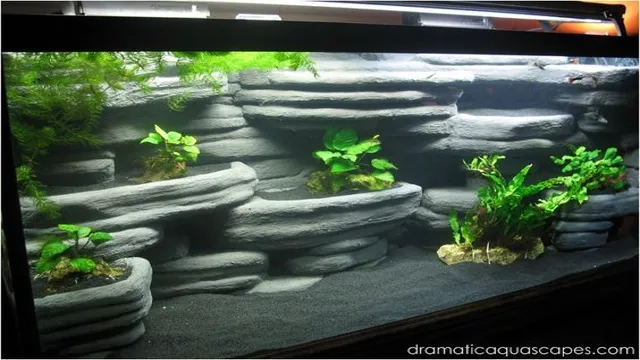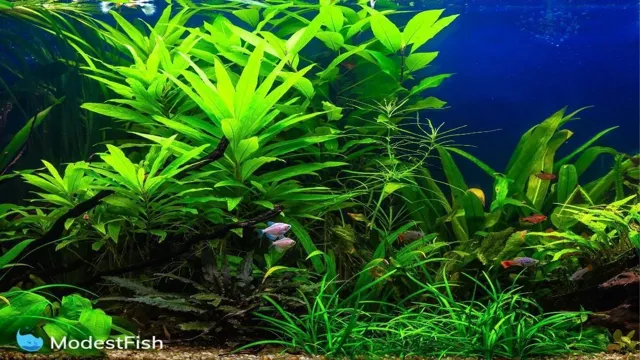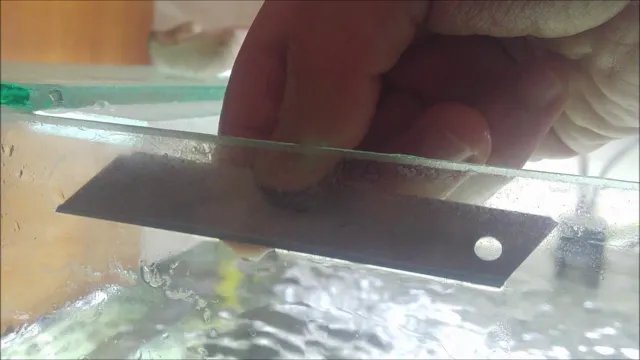How to Make a Rock Background for an Aquarium: Step-by-Step Guide

Transforming your aquarium into a captivating wonderland filled with vibrant living beings can be an incredibly exciting experience. Creating a natural background for your fishes can not only add visual depth but also make your aquarium an esthetic masterpiece that you can be proud of. And rock backgrounds can do just that! Rock backgrounds can help mimic the natural habitat of your fish and provide them with a safe and comfortable space.
But how can you create a rock background for your aquarium without creating a mess or harming your aquatic friends? In this blog, we will discuss everything you need to know about building a rock background for your aquarium and the various techniques you can use to make your aquarium stand out. So let’s dive in and explore these rock-tastic ideas!
Materials Needed
If you’re looking to make a rock background for your aquarium, you’ll need a few materials to get started. First, you’ll need a tank that has a smooth glass or acrylic back. Next, you’ll need some rocks that are safe for aquarium use.
It’s important to avoid any rocks that may have sharp edges or contain minerals that can leach into the water, so you may want to stick with rocks that are specifically marketed for aquariums. You’ll also need some aquarium silicone sealant that is safe for use with fish. This type of sealant is designed to create a permanent bond between the rocks and the back of the aquarium, holding the rocks firmly in place while also providing a waterproof seal.
Finally, you may want some additional materials to help you create the look you’re going for, such as aquarium safe plants or other natural decorations. By gathering all of these materials, you’ll be well on your way to creating a stunning rock background for your aquarium.
Rocks
When it comes to rock collecting, you don’t need a lot of fancy equipment to get started. In fact, all you really need are some basic materials that you probably already have lying around your house. First and foremost, you’ll need a good pair of gloves to protect your hands from rough edges and sharp points.
It’s also a good idea to invest in a rock hammer or chisel, which will allow you to break apart larger rocks and examine their different layers. A magnifying glass is helpful for inspecting small details and distinguishing between different types of rocks. And last but not least, a sturdy backpack or bucket is essential for carrying all of your new specimens.
With just these few simple materials, you’ll be well on your way to building an impressive rock collection.

AquaSafe Epoxy
If you’re planning on using AquaSafe Epoxy for your next project, there are a few materials you’ll need to have on hand. First and foremost, you’ll need to make sure you have a clean and dry surface to work with. This includes any cleaning supplies necessary to remove dirt, dust, and debris from the area.
You’ll also want to use masking tape or other materials to protect any areas that you don’t want to get epoxy on. Once you have your surface prepped, you’ll need to mix the two-part epoxy according to the instructions on the packaging. This usually involves using a mixing cup and stirring stick to combine the resin and hardener until they are well incorporated.
Finally, you’ll need to use a brush or roller to apply the epoxy to your surface. With these materials and some careful application, you can achieve a beautiful and durable finish with AquaSafe Epoxy.
Paintbrush
If you’re looking to get crafty with paint, one essential tool you’ll need is a paintbrush. Luckily, there are many options available that can suit every project. For example, flat brushes are great for larger areas and washes, while round brushes are perfect for detail work and small spaces.
Synthetic brushes are generally cheaper and can be used with various types of paint, while natural hair brushes are more expensive and ideal for specific types of paint like oil or watercolor. Make sure you also have paint thinner or water (depending on the type of paint you’re using), a palette or surface to mix your colors, and a rag or paper towels for cleaning your brush between colors. With the right materials, you’ll be ready to unleash your creativity and make something beautiful with your paintbrush.
Preparing Your Rocks
If you’re thinking of adding a rock background to your aquarium, then the first step is to prepare your rocks. Make sure to choose non-toxic rocks that won’t alter the pH balance or harm your aquatic pets. Wash the rocks thoroughly with warm water to remove any dirt or sand.
You can boil them in water for a few minutes to disinfect them and remove any bacteria. Once cleaned, arrange the rocks in a way that looks natural and aesthetically pleasing. You can use aquarium-safe silicone to adhere the rocks to the background of the tank, making sure to leave enough space for water to circulate.
With a little effort and creativity, you can have a beautiful and functional rock background for your aquarium that will provide your aquatic pets with a comfortable and stimulating environment.
Cleaning
Cleaning your rocks is an essential task to ensure their longevity and keep them looking their best. Before you start, it’s important to prepare your rocks properly. First, remove any loose debris or dirt from the surface of the rocks.
If you’re dealing with stubborn dirt, use a small brush to gently scrub the affected area. Once the rocks are free of dirt, you’ll want to give them a good rinse with water. This will help remove any remaining dirt or loose debris that may have missed during the initial cleaning.
If you plan to use cleaning products, be sure to read the label first and use a cleaning solution that is safe for your particular type of rock. With the proper preparation and cleaning, your rocks will look brand new and ready to be displayed in your outdoor space.
Drying
To properly dry your rocks, it’s important to prepare them beforehand to ensure a successful drying process. Start by removing any excess dirt or debris that you may have collected during your rock hunting adventures. If you have any stubborn dirt or stains on your rocks, use a soft-bristled brush and water to gently scrub them clean.
Once your rocks are clean, place them on a towel or piece of fabric to dry off any excess water. After this initial drying, it’s important to air dry your rocks for an extended period of time. One effective method is to place your rocks on a wire mesh or baking rack in a dry, well-ventilated area for a few days to a week.
This allows for the natural evaporation of any remaining moisture from your rocks. By taking these steps to properly prepare your rocks for drying, you can ensure a successful and efficient process.
Arranging
When it comes to arranging your rocks, preparation is key. Before you start to arrange your rocks, make sure they are clean and dry. Use a brush or cloth to remove any dirt or debris, and allow them to dry completely before you begin your arrangement.
Once your rocks are clean and dry, consider the color, shape, and texture of each stone. Sort them into groups based on these characteristics, and begin to arrange them in a way that is visually pleasing. If you’re arranging rocks in a garden or landscaping project, consider the overall design and style of the space.
Are you going for a natural look or something more structured? Use this information to guide your arrangement and create a cohesive look that fits with your overall vision. By taking the time to prepare your rocks and consider their placement, you can create a beautiful and unique arrangement that adds interest and texture to any space.
Mixing and Applying the Epoxy
Now that you have created a base for your rock background, it’s time to mix and apply the epoxy. The first step is to read the manufacturer’s instructions and safety precautions carefully. Then, mix the epoxy in a well-ventilated area, following the recommended ratio of resin to hardener, usually 1:
Use a stir stick or an electric mixer to blend the components thoroughly. It’s important not to mix too much at once, as the epoxy may harden before you have a chance to apply it. To avoid this, divide the mixture into smaller batches and work on one section at a time.
The epoxy should be applied with a trowel, starting from the bottom and working your way up. Spread it evenly, making sure to fill any gaps and cover the entire surface. Don’t worry if the epoxy looks uneven or lumpy at first, you can smooth it out with a putty knife or a damp sponge.
Once you’re done with each section, let it dry for at least 24 hours before touching or moving it. With a little bit of patience and attention to detail, you’ll soon have a beautiful rock background for your aquarium.
Mixing Instructions
Mixing and applying epoxy can seem like a daunting task, but with the right instructions, it’s actually quite simple. First, make sure to read the manufacturer’s instructions thoroughly before beginning. Typically, you’ll need to mix equal parts of the resin and hardener together, but this may vary depending on the brand.
Use a clean, disposable container and mix the two components together thoroughly with a stir stick. It’s important to mix well, as any unmixed portions can result in uneven curing. Once mixed, you’ll have a set amount of time to work with the epoxy before it begins to harden, so be sure to work quickly.
Apply the mixture to the surface evenly with a brush or roller, and allow proper curing time before handling or adding additional layers. Remember to wear gloves and work in a well-ventilated area for safety. With these simple steps, you’ll be able to successfully mix and apply epoxy for your next project.
Applying the Epoxy to the Rocks
When it comes to applying epoxy to rocks, it’s important to properly mix and apply the substance for the best results. To begin, gather the two-part epoxy and mix it according to the manufacturer’s instructions. This may involve combining equal parts of the resin and hardener and stirring for a set amount of time.
Once mixed, use a small brush or applicator to apply the epoxy onto the rocks. It’s important to work in small batches to avoid the epoxy from hardening prematurely. Take care to spread the epoxy evenly on the surface of the rock and use a toothpick or similar tool to fill in any small cracks or crevices.
The epoxy will dry and harden over time, but it’s important to allow ample curing time before moving or handling the rocks. By following these steps, you can successfully apply epoxy to rocks to create durable and long-lasting pieces.
Creating the Background
Are you looking to create a natural and realistic rock background for your aquarium? Look no further! One way to achieve this is by using a mix of foam board and aquarium-safe silicone. First, cut the foam board to fit the back and sides of your aquarium. Next, form the desired shape of the rocks by cutting and shaping the foam board with a knife.
Then, apply a generous amount of aquarium-safe silicone to the foam board, spreading it evenly with a putty knife or your fingers to create a textured surface that resembles rocks. Allow the silicone to dry completely before moving the background into your tank. Once in place, use aquarium-safe adhesive to secure any plants or decorations to the background.
With a little bit of creativity and some patience, you can create a stunning rock background that will enhance the beauty of your aquarium and give your fish a more natural environment to swim in.
Placing the Rocks
Placing the rocks is a crucial part of creating a background for your aquarium. It not only gives a natural look to the tank but also provides hiding spots for the fish. When choosing rocks, it is important to select ones that are suitable for aquariums, as some rocks can release harmful substances into the water.
The best types of rocks for aquariums are ones that are inert, meaning they won’t affect the pH or hardness of the water. Once you have selected the rocks, it’s time to arrange them in your aquarium. Start by placing the larger rocks at the back of the tank and working your way forward with smaller rocks.
Creating different levels and patterns will give your tank a more natural appearance. Be sure to leave enough space between the rocks for plants to grow and for fish to swim through. With some creativity and patience, you can create a beautiful and natural-looking background for your aquarium that your fish will love.
Allowing the Epoxy to Dry
After mixing and applying the epoxy, it’s important to give it enough time to dry completely before moving on to the next step. The drying time will vary depending on the type of epoxy used and the conditions it’s exposed to, such as temperature and humidity levels. Generally, it’s safest to allow the epoxy to dry overnight before handling.
This will ensure that the background is solid and can withstand any additional layers or embellishments that you may want to add. Rushing the drying process may lead to cracks or bubbles in the epoxy, which can ruin the final product. It may be tempting to try and speed up the process, but it’s better to exercise patience and give the epoxy ample time to cure properly.
Once the background has dried completely, you can begin to build up the layers of your project.
Securing the Rocks to the Tank
In order to create a natural-looking background for your aquarium, securing rocks to the tank is a great way to achieve the desired effect. This also provides a sense of security for your aquatic pets, as they will be able to hide and explore the rocks. The first step in this process is choosing the right rocks for your aquarium.
You’ll want to avoid rocks with sharp edges that could harm your aquatic friends. Once you have the perfect rocks selected, you can begin arranging them in the tank. It’s important to ensure that they are secure and won’t move around, as this could disturb the environment you’ve created.
You can use silicone adhesive to keep the rocks in place and create a solid foundation. By doing this, you’ll create a beautiful and functional background for your aquarium that both you and your pets will appreciate.
Tips and Tricks
If you’re looking to add some natural-looking decor to your aquarium, a rock background can be a great option. Creating one is easier than you might think – all it takes is a little bit of patience and some basic materials. First, start by selecting the type of rock you want to use.
Look for rocks that are smooth and flat, making it easier to stack them on top of each other. Next, thoroughly clean the rocks with warm water and a gentle scrub brush. Allow them to dry completely before beginning construction on your background.
You can use aquarium-safe silicone to attach the rocks to the back of your tank, one layer at a time, working from the bottom up. Be sure to let each layer dry completely before adding the next one. Once all the rocks are in place, let the silicone cure for at least 24 hours before filling the tank with water.
With a little bit of effort, you can create a stunning rock background that will add depth and dimension to your aquarium.
Using Different Types of Rocks
When it comes to using different types of rocks, there are a few tips and tricks to keep in mind to ensure the best results. First, it’s important to choose the right type of rock for your project. Some rocks, such as limestone and sandstone, are more porous and can be prone to cracking in colder temperatures, so they may not be the best choice for outdoor projects in areas with harsh winter climates.
Granite, on the other hand, is a much denser and more durable rock that can withstand a wider range of weather conditions. Secondly, it’s important to consider the color and texture of the rock you’re using. The right combination of colors and textures can create a beautiful and unique look, whether you’re building a rock wall or incorporating rocks into your landscaping.
For example, a blend of different shades of grey and brown can create a natural and earthy look, while a mix of smooth and rough textures can add depth and visual interest. Overall, using different types of rocks can add both functional and aesthetic value to your outdoor projects. By selecting the right type of rock and considering color and texture, you can create a beautiful and durable final product that will last for years to come.
Experimenting with Arrangements
Experimenting with arrangements can be a fun way to liven up any space in your home. Whether it’s rearranging furniture, rearranging decor, or simply switching out a few pieces, making changes to the layout of a room can give it a completely new feel. One tip to keep in mind is to start with a focal point.
If you’re rearranging furniture in a living room, for example, start with the largest piece and build around it. Another trick is to play with symmetry and asymmetry. Arranging decor in a symmetrical manner can create a sense of calm and order, while asymmetry can add a touch of excitement and interest.
Don’t be afraid to mix and match styles and textures either. Combining different elements can make a space feel eclectic and unique. Finally, don’t be afraid to take risks and try something new.
Even if it doesn’t work out perfectly, experimenting with arrangements can lead to unexpected surprises and new discoveries in your home decor.
Maintenance and Cleaning
When it comes to maintaining and cleaning your home, there are a few tips and tricks that can make the process much easier. First, it’s important to establish a cleaning routine to keep things tidy on a regular basis. This routine should include tasks such as wiping down surfaces, vacuuming, and doing laundry.
Additionally, it’s important to regularly declutter and organize your space to prevent build-up of dirt and debris. When it comes to more heavy-duty cleaning tasks, such as deep cleaning carpets or scrubbing the bathroom, choosing the right cleaning products can make all the difference. Look for eco-friendly options that are gentle on surfaces and don’t leave behind harmful chemicals.
Overall, staying on top of maintenance and cleaning tasks can help create a comfortable and healthy living space for you and your family. So next time you’re cleaning, keep these tips in mind to make the process a little less daunting.
Conclusion
So, if you’re looking to create a truly spectacular aquarium, a rock background is the way to go. With a little bit of creativity and ingenuity, you can turn a boring tank into a stunning underwater oasis. Just remember to consider the size and type of rocks you use, and make sure they’re safe for your aquatic friends.
Whether you’re going for a natural-looking underwater paradise or a bold and vibrant statement piece, a rock background is sure to make a splash!”
FAQs
What materials do I need to make a rock background for my aquarium?
To make a rock background for your aquarium, you will need foam, mortar mix, silicone sealant, and rocks or pebbles of your choice.
How do I prepare the foam for a rock background in my aquarium?
Start by measuring and cutting the foam to fit your tank’s back wall, then use a heat gun to shape the foam into a rocky texture.
What type of mortar mix should I use for a rock background in my aquarium?
It is recommended to use a cement-based mortar mix that is safe for aquarium use. Make sure to follow the manufacturer’s instructions carefully.
Can I use any type of rocks or pebbles for a rock background in my aquarium?
No, not all rocks and pebbles are safe for aquarium use. It is important to use rocks that are inert and won’t leach harmful chemicals into the water. Some safe options include lava rock, granite, and slate.
How long should I let the silicone sealant dry before adding water to my aquarium?
It is recommended to let the silicone sealant dry for at least 48 hours before adding water to your aquarium.
Can I add plants to a rock background in my aquarium?
Yes, you can add plants to a rock background. You can either attach the plants directly to the rocks or use plant pots placed on the substrate.
How do I clean a rock background in my aquarium?
To clean a rock background, use a soft-bristled brush or sponge and gently scrub away any algae or debris. Avoid using harsh chemicals or abrasive materials that may scratch the surface.






